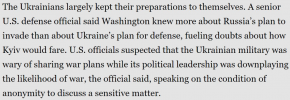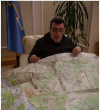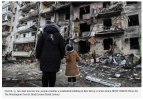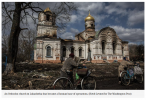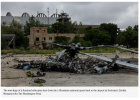
KYIV, Ukraine — A hail of shrapnel from kamikaze drones ripped through the tent where off-duty Ukraine border guards were sleeping near a crossing with Belarus, three hours north of Ukraine’s capital.
Viktor Derevyanko woke to scalding pain, his body burning. Blood spilled from his hand as he tried to wipe his face. A piece of metal had traveled through his arm and stomach and into the muscle around his heart.
“I couldn’t get my bearings,” said Derevyanko, the deputy head of the unit. “Only on the third explosion did I manage to fall out of bed and try to find at least someplace to hide, because the explosions weren’t ending.”
It was around 4:15 a.m. on Feb. 24.
Hours earlier, Derevyanko and the other guards had been joking dismissively about President Joe Biden yet again warning of a Russian invasion. Now they were its first target.
Within minutes, Russian missiles began soaring out of their launchers. They pounded Ukraine air defenses, radar batteries, ammunition depots, airfields and bases, filling the early morning with the sounds of war.
At almost the same time, Ukraine Interior Minister Denis Monastyrsky woke to the ringing of his cellphone. In recent days, he had experienced a rush of relief every time he opened his eyes to the morning light, realizing that the arrival of a new day meant Russia hadn’t invaded. This time, it was still dark. Ukraine’s border guard chief was on the line and told him that his units were battling Russians across three of the country’s northeastern regions.
This wasn’t the limited invasion, isolated to the country’s east, that many top Ukraine officials had been expecting.
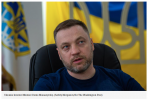
Monastyrsky hung up and dialed President Volodymyr Zelenskyy.
“It has started,” Monastyrsky told the Ukrainian leader.
“What exactly?” Zelenskyy asked.
“Judging by the fact that there are attacks underway at different places all at once, this is it,” he said, telling Zelenskyy that it looked like a full-scale invasion bearing down on Kyiv.
“In the first minutes, they delivered terrible blows to our air defense, terrible blows to our troops in general. ... There were 20-meter craters, the likes of which no one has seen in their lifetimes,” Monastyrsky later recalled.
The question everyone faced at that moment, Monastyrsky said, was: “How far can the enemy go with that enormous fist?”
If the Russians could seize the seat of power in Ukraine, or at least cause the government to flee in panic, the defense of the country would quickly unravel. Moscow could install a puppet government.
That was the Kremlin’s plan.
Instead, what transpired in and around Kyiv in the ensuing 36 days would represent the biggest foreign blunder in the 22-year rule of Russian President Vladimir Putin. His assault on the city instantly reordered the security architecture of Europe against Moscow and isolated his nation to a degree unseen since the Cold War. To the surprise of the world, the offensive against the Ukrainian capital would end in a humiliating retreat, which would expose deep systemic problems in a Russian military he had spent billions to rebuild.
Despite the flaws that would emerge in Russia’s war planning, the outcome of the battle for Kyiv was far from predetermined. This account of how Ukraine forces defended, and saved, their capital is based on interviews with more than 100 people — from Zelenskyy and his advisers, to military commanders, to volunteer militiamen, as well as senior U.S. and European political and military officials.
A reconstruction of events shows that even as Ukraine’s political leadership had downplayed the likelihood of a full-scale invasion, the military had taken critical steps to withstand Russia’s initial assault. Commanders had moved personnel and equipment off bases, despite in many cases their own doubts about what was to come.
Ukraine forces lacked sufficient weaponry, ammunition and communications equipment. But what they did possess was a profound will to fight — one that would extend beyond soldiers to ordinary civilians and, most important, to the president himself.
The defenders would also take advantage of terrain around the capital — dense forests, narrow roads, winding rivers — that favored their guerrilla tactics, as well as weather short of freezing that thawed the land and bogged down Russian vehicles. In particular, the Irpin River, a waterway that marked the line of defense on Kyiv’s western edge, would help protect the capital when Ukrainian forces released dammed water to flood its banks.
Those fighting to save Kyiv also benefited greatly from key miscalculations by the Kremlin, which set in motion a plan to invade Kyiv based on poor assumptions about the mettle of the Ukraine military, the durability of the Zelenskyy government and the determination of the Ukrainian people to resist. In the end, Russia wouldn’t take any territory inside Kyiv’s city limits, instead remaining stuck for weeks on the capital’s periphery before the retreat.
The Kremlin did not respond to requests for comment.
As the war began, Putin was some 475 miles away in Moscow. Seated at a wooden desk in a black suit and maroon tie, he appeared on television to announce what he called a “special operation” to “demilitarize and denazify” Ukraine. Moscow had been left with “no other opportunity to protect Russia other than the one we will be forced to use today,” Putin said.
As the speech finished, booms resounded across Kyiv. Ukraine’s first lady, Olena Zelenska, said she turned over in bed to find an empty space where her husband had been sleeping. She got up and walked over to find him putting on a charcoal gray suit and white shirt. No tie.
“What is happening?” she asked.
“It has started,” Zelenskyy replied. He looked at the faces of his children, ages 17 and 9 before leaving for his office. Zelenskyy said he couldn’t help thinking that Russian missiles were flying “over my children, over all of our children” — that an unthinkable number of Ukrainians were about to die.
The choice Moscow had made, after months of pretend diplomacy, victim-playing and lies on the international stage was beneath all dignity, Zelenskyy thought. He felt certain that Ukrainians shared his fury, that they would fight.
Zelenskyy convened a meeting of his top advisers. They decided that part of the cabinet — including those responsible for police and defense — would stay in Kyiv, as others relocated to western Ukraine. Officials watched wide-eyed as border surveillance cameras captured hundreds of Russian tanks and other armored vehicles flowing into Ukraine in columns reminiscent of a World War II advance. From Belarus in the north. From Russia in the east. From Crimea in the south.
“The whole map was red and required attention,” Monastyrsky said.
The Russians pressed into the hazardous zone around the defunct Chernobyl nuclear plant, where the head of the Ukrainian border guard sector, Vitaliy Yavorskiy, would later find evidence that they had dug trenches in radioactive soil and eaten contaminated deer they shot in the nearby woods.
The goal of the invaders was to penetrate and seize Kyiv, the centuries-old metropolis topped with golden domes above the Dnieper River. Declared the “Mother of Rus Cities” by Oleg of Novgorod when he seized it in the Middle Ages, the city shares a past with Russia that Putin had seized upon to undermine Ukrainian sovereignty. Putin had characterized Russians and Ukrainians as one people separated by Soviet contrivance and Western interference, building a case for going to war to reset history.
As morning broke over Kyiv, Zelenskyy began to work the phones, speaking with President Biden, British Prime Minister Boris Johnson and other leaders to ask for help. Within hours, he sat down at a desk and self-recorded a video to the Ukrainian people — millions of whom had considered an assault on Kyiv an impossibility and were now waking up to explosions and piling into their cars in shock.
“Today I ask you, each one of you, to remain calm. If it is possible, please stay home,” Zelenskyy said. “We are working. The army is working. The entire security and defense sector of Ukraine is working.” He promised to appear later in the day and stay in regular contact, assuring Ukrainians that they would remain strong. “We are ready for anything. We will defeat anyone,” he said. “Glory to Ukraine!”
Inside the government complex in central Kyiv, the head of Zelenskyy’s administration, Andriy Yermak, looked down at his ringing cellphone. It was the Kremlin.
The former entertainment lawyer, a permanent fixture at Zelenskyy’s side, at first couldn’t bring himself to pick up, he said. The phone rang once, then again. He answered. He heard the gravelly voice of Dmitry Kozak, the Kremlin deputy chief of staff, who was born in Ukraine but had long ago entered Putin’s inner circle. Kozak said it was time for the Ukrainians to surrender.
Yermak swore at Kozak and hung up.
Brazen invasion
Bookish and pensive, Gen. Col. Oleksandr Syrsky is the kind of seasoned military officer who plans for all contingencies — even the scenarios he deems highly unlikely.
The notion that Kyiv — where urban warfare would vex even the most sophisticated military — could be Putin’s primary initial target defied belief for most of the Ukrainian elite, even within the armed forces.
“To think the leadership of Russia would unleash such brazen, large-scale aggression, honestly speaking, I could not even imagine it,” recalled Syrsky, who had fought Russia and its separatist proxies in eastern Ukraine and was tapped to lead Kyiv’s defense just before the invasion. “It seemed to me that if active hostilities were to start, they would most likely start in the east, around or within the borders of the Donetsk and Luhansk regions.
“But we’re the military,” said Syrsky, one of several top Ukrainian military and political officials who spoke at length about the battle for Kyiv, some of them, like Syrsky, in their first extensive interviews. “Therefore, regardless of what I believed or didn’t believe, how it all seemed, I still carried out the activities required.”
Given the array of Putin’s forces along Ukraine’s borders, Syrsky had determined that if the Russians did attack Kyiv, their columns would advance along two or three major highways on what they foresaw as a fast, decapitating drive to the government quarter in Kyiv. The Kremlin battle plan assumed the city would be left defended by only weak Ukrainian forces, disoriented by the political chaos as Zelenskyy and his ministers fled.
To protect the city, Syrsky had organized two rings of forces, one in the outer suburbs and one within the capital. He wanted the outer ring to be as far from the inner ring as possible to protect the downtown area from shelling and keep the Russians fighting on the approaches to Kyiv.
Syrsky divided the city and the surrounding region into sectors and assigned generals from the military education centers to lead each area, creating a clear chain of command to which all Ukrainian military units and security services would answer. Tactical decisions would be made immediately by officers on the ground without having to consult headquarters.
About a week before the invasion, the Ukraine military had moved all command posts into the field toward the probable axes of a Russian advance. Syrsky had also issued an order to move the army’s aviation assets, including helicopters and jets, off major bases, putting them well away from obvious airstrike targets.
When it came to tank power, however, only one mechanized brigade, the 72nd, was available to defend the capital — clearly insufficient for such a large city. As a fix, Syrsky said, he ordered all the military education centers to create special makeshift battalions and had the artillery systems normally used for training brought to the capital area.
Some of those systems came from the Divychki training center southeast of Kyiv, where Ukraine years earlier had brought back into service heavy Soviet-era tanks known as 2S7 Pions, or Peonies. Juggernauts of artillery warfare, each weighing 46 tons and carrying 203mm howitzers, they can fire shells of over 240 pounds more than 20 miles.
Syrsky ordered his artillerymen to take up defensive positions outside the city, to the northeast and northwest, the areas likely to face a Russian onslaught.
That single move turned out to be critical, according to Kyiv’s mayor, former boxing champion Vitali Klitschko, because Russia targeted the bases where those systems were normally housed in the very first hours of the war.
“The leadership of the country said there wouldn’t be a war, but the military knew,” Klitschko said.
The Ukrainians largely kept their preparations to themselves. A senior U.S. defense official said Washington knew more about Russia’s plan to invade than about Ukraine’s plan for defense, fueling doubts about how Kyiv would fare. U.S. officials suspected that the Ukrainian military was wary of sharing war plans while its political leadership was downplaying the likelihood of war, the official said, speaking on the condition of anonymity to discuss a sensitive matter.
Ukraine Defense Minister Oleksii Reznikov said he was one of the leaders who didn’t believe an all-out assault was coming.
European officials had been assuring him they didn’t see the same threat the United States and Britain did. According to Ukraine’s own intelligence assessments, Russia also didn’t have enough forces amassed over the border to capture or occupy a city the size of Kyiv.
On Feb. 22, Reznikov had spoken over the phone with his counterpart in Belarus, Viktor Khrenin, who promised that Russian forces on Belarusian territory would not invade — offering his word as an officer, the Ukrainian defense minister said.
“And he was a liar,” Reznikov said.
Two days later, after the invasion had begun, the two men spoke again. Reznikov heard a nervous and uncomfortable voice on the other end of the line. The Belarusian minister said he was conveying a message from his Russian counterpart, Sergei Shoigu, Reznikov recalled: If Ukraine would sign an act of capitulation, the invasion would stop.
Reznikov said he replied, “I am ready to accept the capitulation from the Russian side.”
Attack on Antonov Airport
The Russian helicopters swept low over the Dnieper, their rotor blades slicing the moist winter air in the fold of the river valley. They flew south out of Belarus to a place where the river widens into a placid expanse that locals call a sea, then banked to the suburb of Hostomel, 22 miles northwest of Ukraine’s government quarter.
The Ka-52 Alligator attack helicopters in the group took the lead, opening fire on their target below — Antonov Airport, a cargo and testing facility with a major runway. Putin’s chosen bridgehead for his assault on Kyiv was the very airport CIA Director William J. Burns, during a Jan. 12 visit to Kyiv, had warned Ukraine that Russia would try to seize.
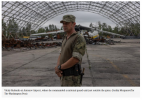
Vitaly Rudenko, a commander at the national guard base just outside the airport gates, looked up in disbelief. “Until the final moment, I didn’t believe it. Maybe I didn’t want to believe it,” he said.
In Kyiv, Ukraine’s military leadership had descended into a fortified shelter. Defense communications aides hurried down the hallway in pursuit of Lt. Gen. Yevhen Moisiuk, the No. 2 officer in Ukraine’s armed forces, to ask him what message they should deliver to Ukrainians as Russian forces entered their towns.
Moisiuk stopped walking and spun around.
“Tell everyone: ‘Kill the occupiers,’ “ Moisiuk said. “Kill the occupiers!”
There were early setbacks at Hostomel. Some of the air defenses the Ukrainians had set up around the airport were hit by strikes before Russia sent in its troop carriers. An employee of the airfield whose son had been recruited by Russian intelligence had revealed their positions, Syrsky said.
The most combat-ready personnel on the base had deployed weeks earlier to Ukraine’s eastern Luhansk region, along with their equipment, leaving the airport and base with about 300 soldiers, including draftees who were serving out Ukraine’s mandatory military service. Many had never seen combat.
The helicopters were circling like a kettle of vultures over the airport, whirring against an overcast sky already black with smoke from missile strikes.
“They opened fire at anything within reach, all the buildings, at any people they saw moving around, regardless of whether they were military or civilians — they didn’t care. They were just firing wherever they detected movement,” said a national guard platoon commander whose radio call sign is Malysh, or Kid. Like others, he withheld his name for security reasons.
As the first helicopters reached the airstrip, Serhiy Falatyuk, a 25-year-old national guardsman, propped an Igla surface-to-air system dating to the Soviet Union on his shoulder, peered through the sight and fired a missile.
It missed.
Falatyuk reloaded, turned his sights on another Russian helicopter and fired again, according to Rudenko. The missile struck the helicopter. Falatyuk screamed in delight.
The small victory electrified the Ukrainian forces, boosting the spirits of Malysh’s draftees. “It was actually possible to shoot [them] down, to do it,” everyone thought, according to Malysh. “The fighters’ morale increased. They grew more persistent. ... Regardless of whether they were conscripts, they were fighters.”
Several Ukrainian air defenses had been moved the day before the invasion, so they remained undisclosed to the Russians and spearheaded a counterattack within minutes, Syrsky said. The Russian pilots struggled under the heavy fire of surface-to-air missiles and antiaircraft artillery, particularly after a direct hit downed one of their leaders.
“They were shooting from all sides. In the first attack, we immediately lost the leader of our group,” Capt. Ivan Boldyrev, one of the Ka-52 pilots, told the Russian state-run defense TV channel Zvezda. Boldyrev had to make an emergency landing after his helicopter suffered damage.
Dozens of civilian employees across the airport ran for the bomb shelter under the cafeteria. Others hid wherever they could, including in the sewers.
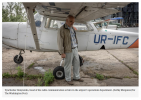
“People ... looked at one another, understood what was happening, but didn’t understand why,” said Vyacheslav Denysenko, one of the Antonov employees.
Outside, Russian forces streamed out of transport helicopters and fanned out to an adjoining small forest and a complex of buildings at the airport.
The Ukrainian soldiers came under constant fire. Outgunned and outnumbered on the grounds of the airport, and facing elite Russian units with far more experience, national guard fighters began to run low on ammunition. “I gave the command ... to retreat,” Rudenko said.
The exit was chaotic. Rudenko ordered the air defense units and scouts to leave by hopping the fence. Guardsmen close enough to vehicles jumped in and sped away. Others ran on foot. Some of the guardsmen were taken prisoner by the Russians.
After the retreat, however, Ukrainian forces opened fire on the airport with heavy artillery they had deployed outside the airport perimeter, blasting the runway to prevent future landings. In addition, late on Feb. 24, two Ukrainian Su-24 bombers swept over the airport and bombed the runway, causing more damage.
Still, the Russians had their bridgehead.
The Ukrainian equivalent of the chairman of the Joint Chiefs of Staff, Gen. Valery Zaluzhny, called Col. Oleksandr Vdovychenko, commander of the 72nd Mechanized Brigade, the only such unit in the Kyiv region and the main force defending the capital.
“We have to retake Hostomel,” Zaluzhny said.
“Mr. Commander in Chief, with all due respect, I don’t have enough forces to take Hostomel,” Vdovychenko recalled responding.
“We should try,” Zaluzhny replied.
Along with elite Ukrainian units, the 72nd Brigade’s troops contested the airport for days, firing artillery barrages and blocking Russian forces struggling to move out of the facility. Moscow had been planning to bring in heavy equipment and more troops on Il-76 cargo aircraft to aid the advance, according to Ukrainian officials, but couldn’t immediately do so.
“That they were able to storm the airfield and take control of it in the course of a few hours, on the one hand, played a negative role [for us],” Syrsky said. “But on the other hand, the artillery fire aimed at the runway and disembarkation sites delayed the landing significantly and frustrated the plan to capture Kyiv, because we know now that in principle the enemy allocated a maximum of up to three days for the capture of Kyiv.”
Later, however, the Russians were able to bring in reinforcements to Hostomel via aircraft, Vdovychenko said.
Over subsequent days, Russian forces already on the ground spread out — into the neighboring suburbs of Bucha and Irpin and the town of Hostomel itself — as they sought to find a route into Kyiv. But a week after the landing, they were still fighting on the streets of Hostomel. A 40-mile-long resupply convoy heading to Hostomel from Belarus ground to a halt north of Kyiv, exposing Russia’s logistical problems.
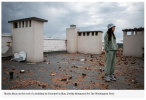
One 31-year-old Hostomel resident, Masha Maas, had been taking cover in the bunker of a glass factory in the center of the town when she saw three Russian soldiers arriving on March 6, after Ukrainian forces had retreated.
“I said, what should we do?” she recalled. “If we close the doors from the inside, they could think someone is left in here and break it or flood it — who knows? If we leave them open, they can shoot us. Take your pick. We decided not to close the doors.”
The first Russian soldier who walked in had blond hair and dark eyes with giant pupils, she recalled. “Why are you looking at me like I’m a fascist?” Maas recalled him saying. “I’m not a fascist. It’s your Ukrainian soldiers who are fascists.”
By March 7, the Russians had occupied the bulk of Hostomel and were using the airport as a hub.
Zaluzhny, the Ukrainian military’s top officer, again spoke to the commander of the 72nd Brigade and ordered him to hold an agreed-upon line on Hostomel’s outskirts and prevent the Russians from advancing any closer to the capital.
“Not one step back,” he said.
The Ukrainians for days blocked the Russian troops from proceeding down the highway toward Kyiv. Frustrated, the Russians tried to find another way into the city. Their best hope: breaking through a forest in the village of Moshchun at the edge of the capital.
-
(jatkuu seuraavassa viestissä)

